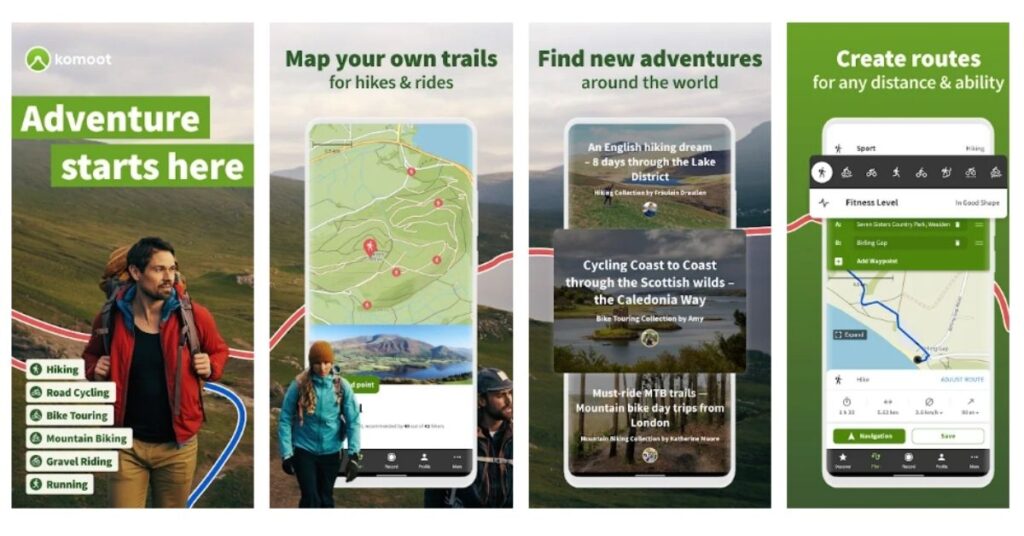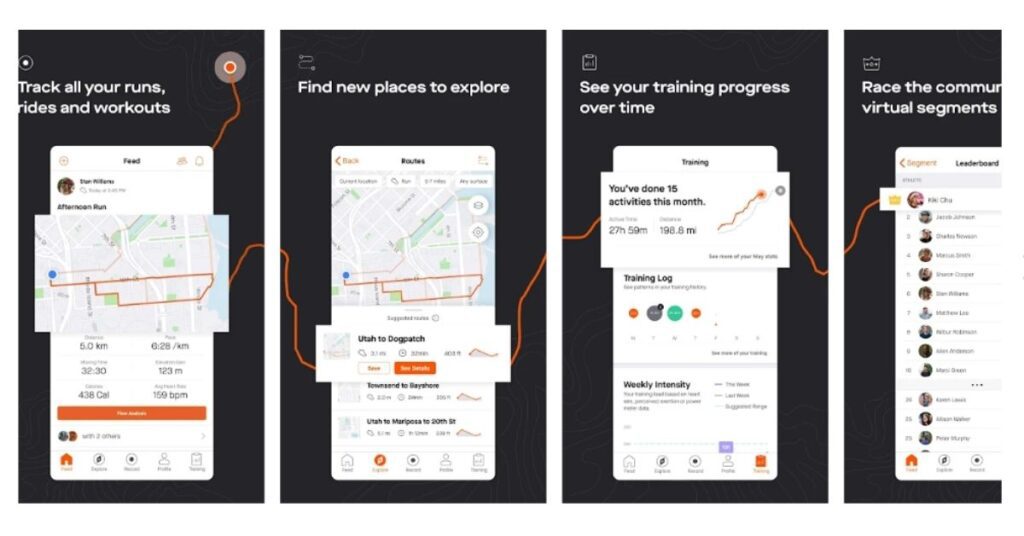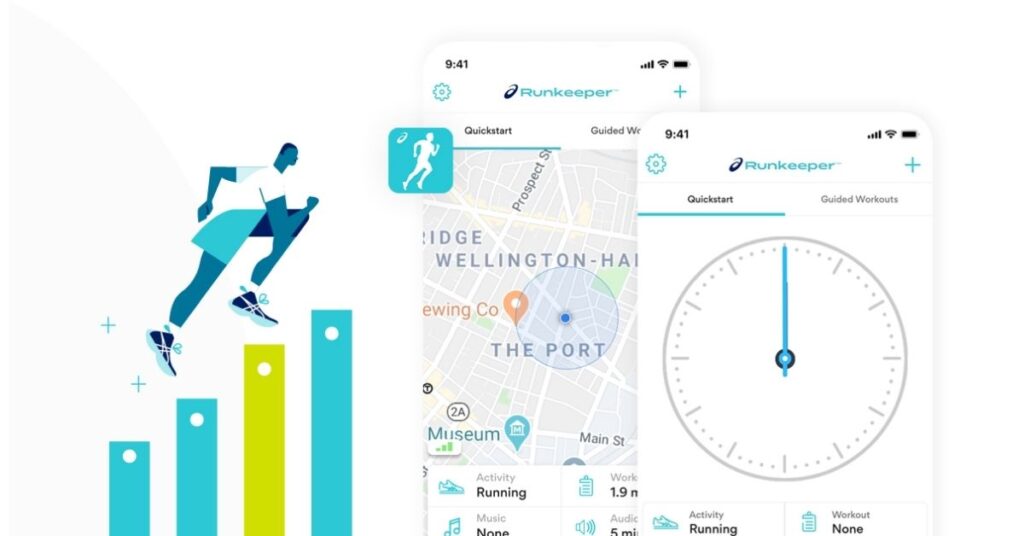Komoot vs Strava vs Runkeeper: We concentrated on a few things when looking for the best running software. Is it simple to operate? Is it correct? Is it possible to export your data? Is it compatible with other services? Is it possible to listen to audio from other applications while you are running?
The fact that you do not spend much time looking at run trackers as opposed to other sorts of applications distinguishes them from other sorts of apps. You start it up and run with it. You want running software that works in the background and stays out of the way.
One thing to keep in mind is that almost all of the applications measured the same things. While operating, all of the apps we tested provide audio alerts. This provides the current distance, pace, and other factors.
Komoot

Komoot is offered as a desktop and mobile app, with most functions accessible via either portal. You may also use your smartphone to navigate, either using the screen for mapping or an earpiece (or the speaker) for turn-by-turn directions, or both. It stands out from the competition thanks to a large amount of handpicked content and a more advanced routing engine.
It will appeal more to those who combine road with gravel and mountain riding (and maybe a little hiking) than out-and-out roadies, but it will be enough for them to justify the price, especially as it is presently a one-time purchase.
Pros
- Routing offers beneficial characteristics
- offline navigation and mapping
- The use of voice guidance is effective.
Drawbacks
- Highlights are only as excellent as the individuals who put them together.
- It is difficult to explore handpicked material.
- It’makes it simpler for you to have real outdoor activities,’ according to Komoot, and this is absolutely true.
- There is solid routing, a lot of curated and automatically created material, and the navigation is really good while you are out and about, with the voice turn-by-turn being the only one I have used that actually works on the bike. It is a good investment for a single one-time payment that is less than the cost of a new front tyre.
Strava

Strava, like all of the other apps we looked at, does an excellent job of monitoring runs. It is truthful and, for the most part, accomplishes what it states. The user interface is simple and straightforward. It also comes with an Apple Watch app for tracking without having to use your iPhone.
For those with a competitive edge, Strava is one of the most popular fitness applications. The software not only keeps track of your runs and bike rides, but it also puts you in a race with other individuals who do the same routes.
To access all the benefits of the app and what it claims to bring, you have to give over a lot of personal data, which has never been managed as effectively as it should have and quite honestly has placed people at risk. Strava syncs with a number of other fitness trackers and running watches, so you don’t need to bring a phone with you to utilize it.
Although the program (which is available for Android and iOS) has certain privacy options, in order to enjoy the full Strava experience, you must be prepared to share some personal information, notably your geolocation data.
Strava’s prior Editors’ Choice title has been removed by PCMag due to the company’s refusal to fundamentally reform how it handles potentially sensitive information, and for asking members to opt out rather than opt in to data sharing.
It is still a good software to use if you take the time to read through the settings and understand the dangers of making your data public. However, as we will explain later, an Editors’ Choice-worthy product would not place so much onus on the user when it comes to preserving their privacy.
Plans and Pricing
Strava, like many other fitness applications, is a freemium service. You may use the app for free, but there are certain restrictions. You can get by just fine with the free version if all you want is an app that records the basics of your exercises and helps you locate new areas to run or bike. You may still compete using the free version, but you will not have access to advanced statistics or a variety of additional features.
Strava Premium provides features that many runners and cyclists may want, but it comes at a steep cost. It costs $7.99 per month (almost $100 per year), or $59.99 if you pay in advance for a year membership.
Pros
- A large number of features are available.
- The importance of community is emphasized.
- Many fitness trackers are supported.
Cons
- Concerns about privacy.
- Premium membership is pricey.
Strava Free vs Paid: Is it Worthless?
RunKeeper

RunKeeper is a program that has been around for quite some time. In fact, the application was first released in 2008. Since then, the app has seen significant changes; it is always being updated and is typically fast to take use of the latest and best Cupertino APIs and hardware.
Main Screen
RunKeeper strikes a good mix between being focused and having access to the broader RunKeeper ecosystem from a design standpoint. When you first open the program, all you have to do is press a button to begin running. The app provides access to all of your data, your friends’ running feed, and your goals screen in addition to the actual run screen.
Statistics
RunKeeper works with both the iOS Music app and Spotify, albeit the latter requires a Premium membership. It is worth noting that iOS allows you to use any music app on top of RunKeeper. This implies you can use Overcast while running, but it is not built into the program. This does not bother me because it is easier for me to search the album on the audio app while jogging.
RunKeeper Goals
The firm behind RunKeeper, FitnessKeeper, also provides an API that allows other app developers to access to RunKeeper’s cloud. This enables programs such as MyFitnessPal to include your runs when calculating your calorie intake.
A Shoe Tracker is one of the features that RunKeeper should provide. Tracking mileage on shoes is vital for heavy runners because they need to be replaced every so often. Someone else added it since RunKeeper didn’t. The Health Graph’s value is this. RunKeeper now allows you to export your data in GPX and CSV formats in addition to the API.
The Health Graph project was a brave move for RunKeeper in a world where services and enterprises want to own your data. They essentially allowed an app to substitute its key functionality of running tracking. However, RunKeeper’s business strategy is straightforward.
RunKeeper is a major player in the fitness market, with over 30 million users. With Asics’ might, they show no signs of slowing down. RunKeeper is my favorite iPhone run tracker since it has a mature feature set, an open API, and a rising user base.
RunKeeper is free, but an Elite subscription ($9.99/month or $39.99/year) unlocks additional features such as deeper data, a goal coach, premium training programs, and the ability to live-stream your runs on the internet. The membership may be purchased through an in-app purchase (IAP) or on RunKeeper’s website.
FAQs: Komoot vs Strava vs Runkeeper
Which app for running is the most accurate?
Runkeeper
Run with Map My Run
Adidas Running App by Runtastic
Pumatrac
Nike Run Club
Strava Running and Cycling
Couch to 5K
Pacer Pedometer
Is it possible to utilize both Runkeeper and Strava at the same time?
To convert your activities from Runkeeper to Strava, use our Upload page to export your activity history in bulk from Runkeeper and upload it to Strava in batches of 25. Hover over the Settings icon in the upper right corner of any page (Gear picture) in your Runkeeper account and select Account Settings.
Is Komoot a better alternative to Strava?
So whether you should use Strava or Komoot is largely determined on the sort of cyclist you are. Strava is the preferable app to use if you want to improve your performance in races and time trials, or if you just want to compete with other cyclists digitally.
Strava vs RunKeeper: which is better?
In response to the question, “What are the best running apps?” RunKeeper is ranked first, with Strava coming in third. The main reason people use RunKeeper is that it uses Google Maps to display your route and monitors distance, time, speed, pace, and calories burnt.

![Komoot vs Strava vs Runkeeper: Which Is Best? [2024]](https://viraltalky.com/wp-content/uploads/2022/04/Komoot-vs-Strava-vs-Runkeeper-3.jpg)